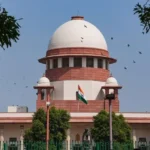After a legal battle that followed the demolition of a mosque in the site of the construction, the temple dedicated to Hindu god Ram is officially open.

A grand temple dedicated to Hindu god Ram has been opened by Indian Prime Minister Narendra Modi in the city of Ayodhya, where a mosque was demolished by Hindu extremists in 1992, triggering deadly communal violence.
The country is due to hold general elections in the coming months and his Bharatiya Janata Party (BJP) is expected to campaign on the issue of Hindu identity in a nation where 80% of the people are Hindu. However, some Hindu leaders and most of the opposition parties stayed away from the event, accusing Mr Modi of using it for political advantage.
The event also stirred fear and resentment among Muslims, India’s largest minority, who recalled the trauma of the 1992 riots that killed nearly 2,000 people, mostly Muslims. Some Muslims in Ayodhya expressed their concerns before the ceremony.
The ceremony was broadcast live on TV and showed Modi performing rituals with priests and Mohan Bhagwat, the chief of the Rashtriya Swayamsevak Sangh (RSS) – the main source of Hindu nationalist ideology.
“This day will be etched in history,” Mr Modi said afterwards. “After years of struggle and countless sacrifices, Lord Ram has come home. I congratulate every citizen of the country on this historic occasion.”
The temple, which cost $217m and was funded by private donations, is only partially completed – the rest is expected to be finished by the end of the year. The project is part of a larger makeover for the city, which is estimated to cost more than $3bn.
The temple fulfils a long-standing promise of Hindu nationalists, who believe that the Babri mosque was built by Muslim invaders over the remains of a temple where Ram was born. The campaign to build the temple boosted the BJP’s rise to power in the 1990s.
The event was celebrated by thousands of Hindu devotees who waved flags and played drums. Also military helicopters dropped flower petals over the temple. The city was decorated with saffron flags featuring images of Ram, as well as banners with the pictures of Narendra Modi and Uttar Pradesh Chief Minister Yogi Adityanath.

Some of India’s most famous celebrities, such as Bollywood actor Amitabh Bachchan and cricketer Sachin Tendulkar, were present at the event. In many other northern cities, Hindus lit lamps and saffron flags with Ram’s images flew on rooftops, including in parts of Delhi. Cinemas showed the event and big screens displayed images from Ayodhya in public places and residential areas.
The ceremony, known as Pran Pratishtha, which means “installation of life force” in Sanskrit, lasted for about an hour. Hindus believe that chanting mantras and performing rituals around a fire will infuse life into an idol or a picture of a deity.
Several local TV channels set up large stages near the river Saryu, a tributary of the Ganges, behind the temple, and covered the event extensively, some declaring the moment of consecration as the beginning of “Ram Rajya” (Lord Ram’s reign) in India.
The opening of a Hindu temple to god Ram in Ayodhya, where a mosque was razed by Hindu radicals in 1992, sparking deadly sectarian clashes, was celebrated by Hindus in other countries as well. In New York, huge billboards of Ram adorned Times Square, where some devotees gathered in the cold night.
The event was also observed in temples across the United Kingdom, where Indians form one of the biggest diaspora groups. They shared colourful posters to invite devotees to join the occasion and celebrated with flowers, sweets and music.
In Dubai, a Muslim-majority city where Indians are a large population, there were some celebrations too, but they seemed less enthusiastic than elsewhere, according to Indian media reports.
In 2019, the Supreme Court awarded the disputed site to Hindus after a long legal battle that followed the mosque’s destruction. Muslims were allotted a land outside the city for a mosque, but they have not built it yet.
The construction of the temple started on 2020 after a Bhoomi Pujan ceremony, which counted with the presence of Indian PM Narendra Modi.

A Muslim resident of Ayodhya told the BBC before the inauguration that he accepted the Supreme Court’s decision to give the site to Hindus. “We were not happy with that decision, but what can we do,” he said. Another one said he was glad Hindus were building the temple – “but we are also sad because it came after demolishing a mosque”.
The new temple, which has three floors and is made of pink sandstone and black granite, covers 7.2 acres in a 70-acre complex. A 51-inch (4.25-ft) idol of the god, specially made for the temple, was revealed last week. The idol has been placed on a marble base in the innermost chamber.
Thousands of police officers were on duty for the event, even though Modi had asked pilgrims to stay away and watch the ceremony on TV. Many states declared a full or half day holiday, with schools, colleges and stock markets closed.
However, some top religious leaders said that performing the rituals at the temple was against Hinduism, since it was not fully completed, and many opposition politicians chose not to attend.
Some states ruled by the opposition also had their own plans for the day. West Bengal Chief Minister Mamata Banerjee said she would worship at the famous temple to goddess Kali in Kolkata and then lead a rally of different faiths. The eastern state of Odisha (Orissa) announced big plans to bring pilgrims to the Jagannath temple in Puri, one of the most sacred places for Hindus.
Officials say they expect more than 150,000 visitors per day when the temple in Ayodhya is fully ready. To handle this expected influx, new hotels are being constructed and existing ones renovated as part of a major makeover and in recent weeks, a new airport and railway station have opened.
Officials say they are creating a “world-class city where people come as pilgrims and tourists”.







